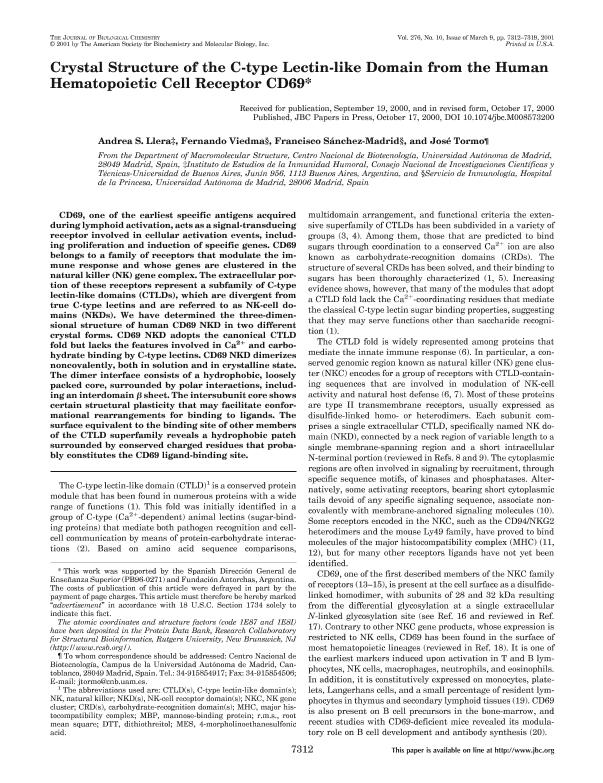Mostrar el registro sencillo del ítem
dc.contributor.author
Llera, Andrea Sabina

dc.contributor.author
Viedma, Fernando
dc.contributor.author
Sánchez Madrid, Francisco
dc.contributor.author
Tormo, José
dc.date.available
2018-05-16T15:46:02Z
dc.date.issued
2001-03
dc.identifier.citation
Llera, Andrea Sabina; Viedma, Fernando; Sánchez Madrid, Francisco; Tormo, José; Crystal Structure of the C-type Lectin-like Domain from the Human Hematopoietic Cell Receptor CD69; American Society for Biochemistry and Molecular Biology; Journal of Biological Chemistry (online); 276; 10; 3-2001; 7312-7319
dc.identifier.issn
0021-9258
dc.identifier.uri
http://hdl.handle.net/11336/45350
dc.description.abstract
CD69, one of the earliest specific antigens acquired during lymphoid activation, acts as a signal-transducing receptor involved in cellular activation events, including proliferation and induction of specific genes. CD69 belongs to a family of receptors that modulate the immune response and whose genes are clustered in the natural killer (NK) gene complex. The extracellular portion of these receptors represent a subfamily of C-type lectin-like domains (CTLDs), which are divergent from true C-type lectins and are referred to as NK-cell domains (NKDs). We have determined the three-dimensional structure of human CD69 NKD in two different crystal forms. CD69 NKD adopts the canonical CTLD fold but lacks the features involved in Ca(2+) and carbohydrate binding by C-type lectins. CD69 NKD dimerizes noncovalently, both in solution and in crystalline state. The dimer interface consists of a hydrophobic, loosely packed core, surrounded by polar interactions, including an interdomain beta sheet. The intersubunit core shows certain structural plasticity that may facilitate conformational rearrangements for binding to ligands. The surface equivalent to the binding site of other members of the CTLD superfamily reveals a hydrophobic patch surrounded by conserved charged residues that probably constitutes the CD69 ligand-binding site.
dc.format
application/pdf
dc.language.iso
eng
dc.publisher
American Society for Biochemistry and Molecular Biology

dc.rights
info:eu-repo/semantics/openAccess
dc.rights.uri
https://creativecommons.org/licenses/by-nc-sa/2.5/ar/
dc.subject
Antigens
dc.subject
Signal Transduction
dc.subject.classification
Otras Ciencias Biológicas

dc.subject.classification
Ciencias Biológicas

dc.subject.classification
CIENCIAS NATURALES Y EXACTAS

dc.title
Crystal Structure of the C-type Lectin-like Domain from the Human Hematopoietic Cell Receptor CD69
dc.type
info:eu-repo/semantics/article
dc.type
info:ar-repo/semantics/artículo
dc.type
info:eu-repo/semantics/publishedVersion
dc.date.updated
2018-05-10T15:45:36Z
dc.identifier.eissn
1083-351X
dc.journal.volume
276
dc.journal.number
10
dc.journal.pagination
7312-7319
dc.journal.pais
Estados Unidos

dc.journal.ciudad
Bethesda
dc.description.fil
Fil: Llera, Andrea Sabina. Consejo Nacional de Investigaciones Científicas y Técnicas. Oficina de Coordinación Administrativa Parque Centenario. Instituto de Investigaciones Bioquímicas de Buenos Aires. Fundación Instituto Leloir. Instituto de Investigaciones Bioquímicas de Buenos Aires; Argentina
dc.description.fil
Fil: Viedma, Fernando. Universidad Autónoma de Madrid; España
dc.description.fil
Fil: Sánchez Madrid, Francisco. Universidad Autónoma de Madrid; España
dc.description.fil
Fil: Tormo, José. Universidad Autónoma de Madrid; España
dc.journal.title
Journal of Biological Chemistry (online)

dc.relation.alternativeid
info:eu-repo/semantics/altIdentifier/url/http://www.jbc.org/content/276/10/7312.long
dc.relation.alternativeid
info:eu-repo/semantics/altIdentifier/doi/http://dx.doi.org/10.1074/jbc.M008573200
Archivos asociados
